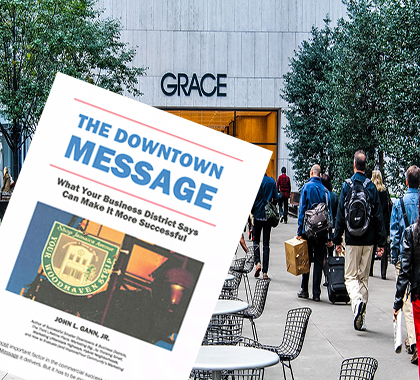Attracting consumers to spend time and money in downtown areas is a struggle many business owners and lawmakers face, and a new manual by an urban planning expert explains how to accomplish that goal.
In The Downtown Message: What Your Business District Says Can Make It More Successful, author and urban development expert John Gann explains how businesses and governments can work together to attract consumers to downtown areas, by reforming the “messages” those areas give people.
Unconventional Conclusion
This manual is targeted at business owners and city lawmakers, who are busy and may have little interest in abstract theories and hypotheticals. Instead of wasting time pontificating, Gann fills his book with real-world experiences and case studies based on real data and research, reaching what he calls an “unconventional conclusion.”
“This manual is based on an unconventional conclusion,” Gann wrote. “It is that the most important factor in the commercial success of a downtown business area is the message it delivers. … This manual is concerned with the commercial success of downtown, which significantly happens to be the support for downtown’s other roles. There are similarly diverse ideas about what kind of place downtown is. This manual endorses its original function as a place of business and recognizes that business is still its sine qua non.”
Explaining Urban Research
The manual is divided into three main parts, with numerous, easily digested subsections that include numerous citations and real-world examples.
Citing research by scholars such as William Whyte and Paco Underhill, Gann explains why most centralized urban planning fails to revitalize downtown areas. Instead of attempting to create prescriptive spaces for people, planning should create spaces defined by what people do there, Gann says.
“Whyte and Underhill watched people respond to the message the physical environment sent,” Gann wrote. “As practitioners with backgrounds in urban planning, Whyte and Underhill were contrarians. Planners typically try to prescribe behavior for the public rather than observe and accommodate what people do. These two researchers were content to go where the people led them. Downtown business areas can do better if they follow their example.”
Competing for People’s Time
Many people are already visiting downtown, Gann writes, so business owners must convince people to shop downtown instead of doing other things during those visits.
“Unlike nearly all shopping malls and highway commercial strips, downtowns are multifunctional places,” Gann writes. “They are not just stores. People who have no interest in shopping come downtown every day. Their doctor is there; the post office is there; the bus terminal or train station is there; city hall and the county courthouse are there; and the museum and public library are there, as is the theatre or performing arts center. Most important, jobs are there. More people come downtown to make money than to spend it, but a concentration of people in an area where there are stores is still what every retailer wants. In downtown, there are lots of people who came without any marketing expenditure by the store to bring them in, but they’re not there to shop.”
That’s an opportunity for retailers, Gann notes.
“And, because shoppers are busy these days and have less time to spend shopping, those non-shoppers are especially valuable,” Gann wrote. “So, it is important to be able to sell downtown and its stores to people who are not shopping.”
Unintentional Messaging
Downtown areas face challenges, and one of those challenges is the messages people receive from the environment.
For example, a sign marked “Parking Limit 30 Minutes” tells people they shouldn’t stay for long periods downtown, and parking meters give the impression to people “parking downtown is a privilege, for which you shoppers have to pay.”
Advantages Over Other Spaces
Gann concludes it’s possible to fix downtowns, because these areas have many advantages not enjoyed by other spaces, such as shopping malls and suburbs.
“The best shopping—indeed, the best anything—is never rushed,” Gann wrote. “Shopping streets downtown are low speed affairs compared with the suburban highways that host the malls, big boxes, and strip centers. Downtown lower speed limits and more traffic slow cars down. That gives prospects a better chance to see a store or its sign for a few more seconds, and an impromptu stop generated by that sighting is easier and safer to do on a low-speed road. People walk in a Downtown. They never walk along the highway where the newer competing stores are. You see more when you’re walking because of your slow speed, and it’s always easy and safe to slow down if a store catches your eye.”
Gann’s The Downtown Message: What Your Business District Says Can Make It More Successful is a clear-eyed explanation of the challenges downtown business owners and lawmakers face, offering great insights into how consumer-driven psychology and marketing can help revive struggling economic districts.





